KT&C EZHD-TVL16, EZHD-TRF4 User Manual
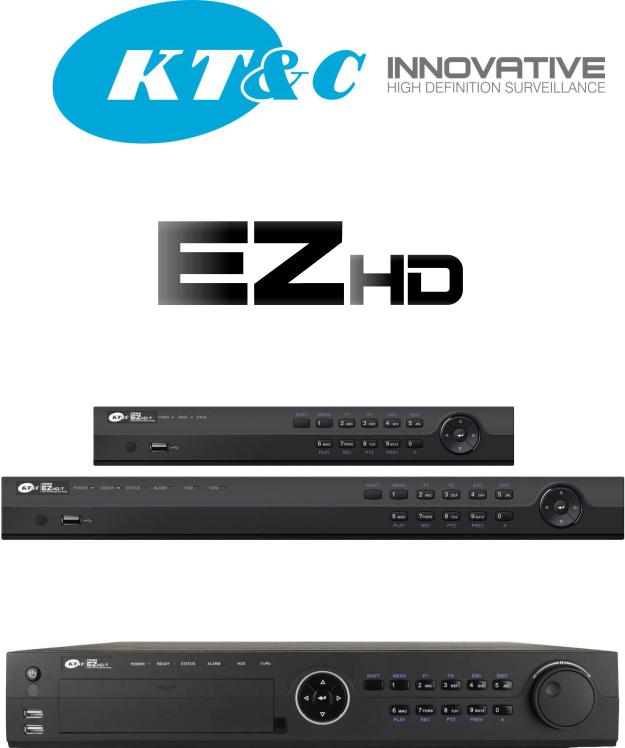
Triple Technology Recorders
960H – EZHD – IP
EZHD-TVL4/EZHD-TVL8/EZHD-TVL16
EZHD-TRF4/EZHD-TRF8/EZHD-TRF16
User Manual
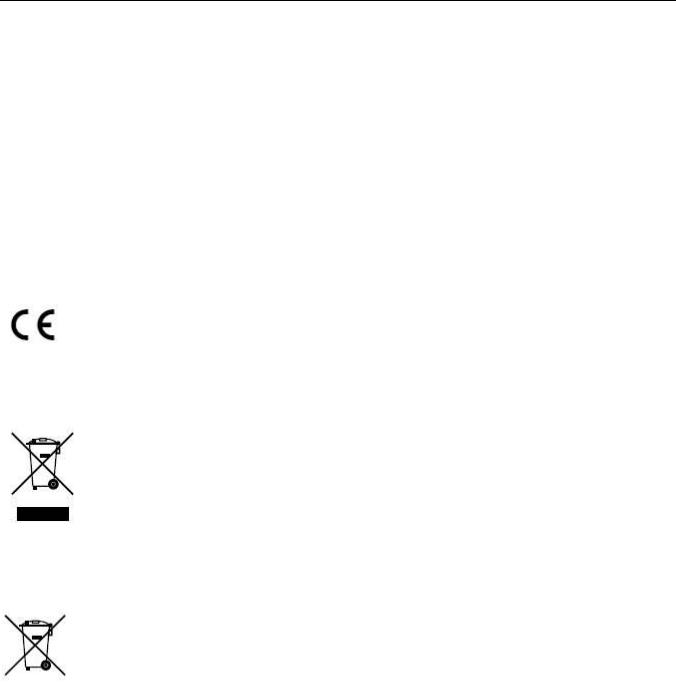
User Manual of Digital Video Recorder User Manual
Regulatory information FCC information
FCC compliance: This equipment has been tested and found to comply with the limits for a digital device, pursuant to part 15 of the FCC Rules. These limits are designed to provide reasonable protection against harmful interference when the equipment is operated in a commercial environment. This equipment generates, uses, and can radiate radio frequency energy and, if not installed and used in accordance with the instruction manual, may cause harmful interference to radio communications. Operation of this equipment in a residential area is likely to cause harmful interference in which case the user will be required to correct the interference at his own expense.
FCC conditions
This device complies with part 15 of the FCC Rules. Operation is subject to the following two conditions:
1.This device may not cause harmful interference.
2.This device must accept any interference received, including interference that may cause undesired operation.
EU Conformity Statement
This product and - if applicable - the supplied accessories too are marked with "CE" and comply therefore with the applicable harmonized European standards listed under the Low Voltage Directive 2006/95/EC, the EMC Directive 2004/108/EC, the RoHS Directive 2011/65/EU.
2012/19/EU (WEEE directive): Products marked with this symbol cannot be disposed of as unsorted municipal waste in the European Union. For proper recycling, return this product to your local supplier upon the purchase of equivalent new equipment, or dispose of it at designated collection points. For more information, see: www.recyclethis.info.
2006/66/EC (battery directive): This product contains a battery that cannot be disposed of as unsorted municipal waste in the European Union. See the product documentation for specific battery information. The battery is marked with this symbol, which may include lettering to indicate cadmium (Cd), lead (Pb), or mercury (Hg). For proper recycling, return the battery to your supplier or to a designated collection point. For more information see: www.recyclethis.info.
2

User Manual of Digital Video Recorder User Manual
Preventive and Cautionary Tips
Before connecting and operating your device, please be advised of the following information:
•Ensure that the unit is installed in a well-ventilated, dust-free environment.
•These units are designed for indoor use only.
•Keep all liquids away from the recorder.
•Ensure environmental conditions meet factory specifications.
•Ensure that the unit is properly secured to a rack (depending on model) or shelf. Major shocks or jolts to the unit as a result of dropping it may cause damage to the sensitive electronics within the unit.
•Use the device in conjunction with an UPS if possible.
•Powering down the unit before connecting and disconnecting accessories and peripherals is recommended.
•A factory recommended HDD should be used for this device.
•Improper use or replacement of batteries may result in risk of explosion or other hazards. Replace batteries with the same or equivalent type only. Dispose of used batteries according to the instructions provided by the battery manufacturer.
Trademarks and Registered Trademarks
•Windows and Windows mark are trademarks or registered trademarks of Microsoft Corporation in the United States and/or other countries.
•HDMI, HDMI mark and High-Definition Multimedia Interface are trademarks or registered trademarks of HDMI Licensing LLC.
•The products contained in this manual are authorized by HDMI Licensing LLC with the use right of the HDMI technology.
•VGA is the trademark of IBM.
•UPnPTM is a certification mark of the UPnPTM Implementers Corporation.
•Other names of companies and product contained in this manual may be trademarks or registered trademarks of their respective owners.
3

User Manual of Digital Video Recorder User Manual
Thank you for purchasing our product. If there is any question or request, please do not hesitate to contact your dealer. KT&C Certified Dealers can contact KT&C directly.
This manual is applicable to the EZHD Series HD-TVI digital video recorders. It is based on the features and functions incorporated in V3.0.4 firmware. Please consult the KT&C website for updated firmware and descriptions of new features and functions which may have been added via new firmware releases.
This manual may contain inadvertent technical discrepancies or printing errors; also, as KT&C reserves the right to update and improve our products, the content is subject to change without notice. Updates describing changes will be added into new versions of this manual as soon as practical, and additional information may be posted to our website, in technical bulletins, or distributed by other means.
4

User Manual of Digital Video Recorder User Manual
Product Key Features
General
Connectable to both HD-TVI and analog cameras with automatic format detection/adjustment
Up-the-cable control of cameras that respond to Coaxitron type signaling
One (EZHD-TVL4) or two (all other models) bonus OMNI IP Plug-and-Play channels without sacrificing any BNC connected channels
Each channel supports dual-stream recording. Main stream supports up to 1080p resolution and sub-stream supports up to WD1 resolution
Independent configuration for each stream for each channel, including resolution, frame rate, bit rate, image quality, etc.
Audio and video synchronization during composite video/audio stream encoding
Watermark technology to validate and/or detect modification of exported video
Local Monitoring
Simultaneous HDMI, VGA and CVBS outputs (no CVBS output for EZHD-TVL4/8/16 models)
HDMI output and VGA output at up to 1920*1080 resolution;
1/4/6/8/9/16 camera live view screens, with control of camera placement and sequencing
Selected live view channels can be hidden (covert)
Motion detection, video-tampering detection, video exception alarm and video loss alarm functions
Privacy masking
Several PTZ protocols are supported, including PTZ preset, patrol and pattern
Zoom in/out by mouse click, and PTZ movement by dragging mouse pointer
HDD Management
For EZHD-TVL4 and EZHD-TVL8, 1 SATA hard disk can be connected For EZHD-TVL-16 up to 2 SATA hard disks can be connected
For EZHD-TRF4/8/16 models 4 SATA hard disks and 1 eSATA disk can be connected (Each disk with a maximum of 4TB storage capacity.)
8 network disks (8 NAS disks, or 7 NAS disks+1 IP SAN disk) can be connected
For recording or backup eSATA disks are supported
S.M.A.R.T. diagnostics and bad sector detection are supported
HDD sleep function is supported
HDD properties include redundancy (with multiple disks), read-only, read/write (R/W);
HDD group management (with multiple disks)
HDD quota management; different capacities can be assigned to different channels
Recording and Playback
Holiday recording schedule configuration
Overwrite and non-overwrite recording modes
Separate normal and event video recording parameters
Multiple recording types: manual, continuous, alarm, motion, motion | alarm, motion & alarm
8 recording time periods with individual record types
Pre-record and post-record for motion detection triggered recording, and pre-record for schedule and manual recording
5

User Manual of Digital Video Recorder User Manual
Search record files by event type (alarm input/motion detection)
Customization of tags, with search and playback back by tags
Locking and unlocking of record files
Local redundant recording
Search and playback of record files by camera number, recording type, start time, end time, etc.
Smart playback to skip through periods where the is no motion in scene
Digital zoom in for any area during playback
Reverse playback of multi-channel views
Pause, fast forward, slow forward, skip forward, and skip backward during playback; scroll through video by dragging the mouse on the progress bar;
Up to 16-ch synchronous playback at 1080p
Backup
Export data to a USB, SATA or eSATA device (for models with eSATA ports)
Export video clips during playback
Management and maintenance of backup devices
Alarm and Exception
Configurable arming time schedule for alarm input/output (for models with alarm I/O)
Alarm for video loss, motion detection, video tampering, abnormal signal, video input/recording resolution mismatch, illegal login, network disconnect, IP address conflict, record exception, HDD error, and HDD full, etc.
Alarms can trigger full screen display, audio alarm, notification to CMS PC, sending email and alarm output (for models with alarm I/O)
Automatic restore when system returns to normal
Other Local Functions
Manual and automatic video quality diagnostics
Users can operate the system using a mouse and/or IR remote control
Three-level user management; admin ID can create many other accounts and define their operating permissions, which includes per-channel access control
Log search and export for various types of operation, alarm/event and exception entries
Manually triggering and clearing of alarms
Import and export of device configuration information
Automatic determination of connected camera signal type
Network Functions
Self-adaptive network interface 10M/100M for EZHD-TRF4/8, 10M/100M/1000M for other models
IPv6 is supported
TCP/IP protocol, PPPoE, DHCP, DNS, DDNS, NTP, SADP, SMTP, SNMP, NFS, iSCSI, UPnP™ and HTTPS are supported
Free SIMPLEDDNS – static IP is not required for reliable WAN connection
TCP, UDP and RTP for unicast;
Auto/Manual port mapping by UPnPTM ;
Remote search, playback, download, locking/unlocking record files, with automatic resumption of interrupted file download
Remote parameter setup; remote import/export of device parameters
Remote viewing of device status, system logs and alarm status
6

User Manual of Digital Video Recorder User Manual
Remote locking and unlocking of control panel and mouse
Remote HDD formatting and firmware upgrade
Remote system restart and shutdown
Supports upgrading via remote FTP server
RS-485 transparent channel transmission
Alarm and exception information can be sent to CMS PC
Remotely start/stop recording
Remotely start/stop alarm output
Remote PTZ control (including up-the-cable access to UTC enabled camera OSD menus)
Remote JPEG capture
Two-way audio and voice broadcast
Embedded multi-broswer WEB server
7

User Manual of Digital Video Recorder User Manual
|
|
Table of Contents |
|
Product Key Features................................................................................................................................. |
5 |
||
Chapter 1 Introduction.................................................................................................................................. |
12 |
||
1.1 |
Front Panels................................................................................................................................... |
13 |
|
1.2 |
IR Remote Control Operations...................................................................................................... |
16 |
|
1.3 |
USB Mouse Operation .................................................................................................................. |
18 |
|
Input Method Description ........................................................................................................................ |
19 |
||
1.4 |
EZHD-TVL Rear Panels ............................................................................................................... |
20 |
|
1.5 |
RS-485 Connection EZHD-TVL................................................................................................... |
20 |
|
1.6 |
EZHD-TRF Rear Panels................................................................................................................ |
21 |
|
1.7 |
EZHD-TRF Peripheral Connections ............................................................................................. |
22 |
|
Wiring of Alarm Inputs ......................................................................................................................... |
22 |
||
Wiring of Alarm Outputs ...................................................................................................................... |
22 |
||
1.8 |
Alarm Connection ......................................................................................................................... |
23 |
|
1.9 |
RS-485 Connection ....................................................................................................................... |
23 |
|
Chapter 2 Getting Started ............................................................................................................................. |
25 |
||
2.1 |
Starting Up and Shutting Down the DVR ..................................................................................... |
26 |
|
2.2 |
Using the Wizard for Basic Configuration .................................................................................... |
28 |
|
2.3 |
Adding/Connecting OMNI IP Cameras......................................................................................... |
32 |
|
|
2.3.1 Adding Online OMNI IP PnP Cameras ............................................................................... |
32 |
|
|
2.3.2 Editing the Connected IP Cameras and Configuring Customized Protocols........................ |
35 |
|
Chapter 3 Live View ...................................................................................................................................... |
37 |
||
3.1 |
Introduction to Live View ............................................................................................................. |
38 |
|
3.2 |
Operations in Live View Mode ..................................................................................................... |
39 |
|
|
3.2.1 |
Front Panel Operation.......................................................................................................... |
39 |
|
3.2.2 Using the Mouse in Live View ............................................................................................ |
40 |
|
|
3.2.3 Using an Auxiliary Monitor [EZHD-TRF models].............................................................. |
41 |
|
|
3.2.4 Main/Aux Output Switching [EZHD-TRF models]............................................................. |
41 |
|
|
3.2.5 Quick Setting Toolbar in Live View Mode .......................................................................... |
42 |
|
3.3 |
Channel-zero Encoding ................................................................................................................. |
44 |
|
3.4 |
Adjusting Live View Settings........................................................................................................ |
45 |
|
3.5 |
Manual Video Quality Diagnostics................................................................................................ |
46 |
|
3.6 |
User Logout................................................................................................................................... |
47 |
|
Chapter 4 PTZ Controls................................................................................................................................ |
48 |
||
4.1 |
Configuring PTZ Settings ............................................................................................................. |
49 |
|
4.2 |
Setting PTZ Presets, Patrols & Patterns ........................................................................................ |
51 |
|
|
4.2.1 |
Customizing Presets ............................................................................................................ |
51 |
|
4.2.2 |
Calling Presets ..................................................................................................................... |
51 |
|
4.2.3 |
Customizing Patrols............................................................................................................. |
52 |
8

User Manual of Digital Video Recorder User Manual
|
4.2.4 |
Calling Patrols ..................................................................................................................... |
53 |
|
4.2.5 |
Customizing Patterns ........................................................................................................... |
54 |
|
4.2.6 |
Calling Patterns.................................................................................................................... |
55 |
|
4.2.7 Customizing Linear Scan Limit ........................................................................................... |
55 |
|
|
4.2.8 |
Calling Linear Scan ............................................................................................................. |
56 |
|
4.2.9 |
One-touch Park .................................................................................................................... |
57 |
4.3 |
PTZ Control Panel......................................................................................................................... |
58 |
|
Chapter 5 Recording Settings ....................................................................................................................... |
59 |
||
5.1 |
Configuring Encoding Parameters ................................................................................................ |
60 |
|
5.2 |
Configuring Record Schedule ....................................................................................................... |
63 |
|
5.3 |
Configuring Motion Detection Record.......................................................................................... |
66 |
|
5.4 |
Configuring Alarm Triggered Record............................................................................................ |
68 |
|
5.5 |
Manual Record .............................................................................................................................. |
70 |
|
5.6 |
Configuring Holiday Record ......................................................................................................... |
71 |
|
5.7 |
Configuring Redundant Recording [EZHD-TRF] ......................................................................... |
73 |
|
5.8 |
Configuring HDD Group for Recording ....................................................................................... |
75 |
|
5.9 |
File Protection ............................................................................................................................... |
76 |
|
Chapter 6 Playback ....................................................................................................................................... |
78 |
||
6.1 |
Playing Back Record Files ............................................................................................................ |
79 |
|
|
6.1.1 Playing Back by Channel..................................................................................................... |
79 |
|
|
6.1.2 Playing Back by Time.......................................................................................................... |
81 |
|
|
6.1.3 Playing Back by Event Search............................................................................................. |
83 |
|
|
6.1.4 Playing Back by Tag ............................................................................................................ |
86 |
|
|
6.1.5 |
Smart Playback .................................................................................................................... |
89 |
|
6.1.6 Playing Back by System Logs ............................................................................................. |
90 |
|
|
6.1.7 Playing Back External Files................................................................................................. |
91 |
|
6.2 |
Auxiliary Functions of Playback ................................................................................................... |
93 |
|
|
6.2.1 Playing Back Frame by Frame............................................................................................. |
93 |
|
|
6.2.2 |
Smart Search........................................................................................................................ |
93 |
|
6.2.3 |
Digital Zoom ....................................................................................................................... |
95 |
|
6.2.4 Reverse Playback of Multi-channels.................................................................................... |
95 |
|
Chapter 7 Backup .......................................................................................................................................... |
97 |
||
7.1 |
Backing up Record Files ............................................................................................................... |
98 |
|
|
7.1.1 Backing Up Using Normal Video Search ............................................................................ |
98 |
|
|
7.1.2 Backing Up Using Event Search........................................................................................ |
102 |
|
|
7.1.3 Backing up Video Clips ..................................................................................................... |
104 |
|
7.2 |
Managing Backup Devices.......................................................................................................... |
107 |
|
Chapter 8 Alarm Settings............................................................................................................................. |
110 |
||
8.1 |
Setting Motion Detection ............................................................................................................. |
111 |
|
8.2 |
Setting Sensor Alarms ................................................................................................................. |
113 |
|
8.3 |
Detecting Video Loss .................................................................................................................. |
116 |
|
9

User Manual of Digital Video Recorder User Manual
8.4 |
Detecting Video Tampering......................................................................................................... |
118 |
|
8.5 |
Setting All-day Video Quality Diagnostics.................................................................................. |
120 |
|
8.6 |
Handling Exceptions ................................................................................................................... |
121 |
|
8.7 |
Setting Alarm Response Actions ................................................................................................. |
123 |
|
8.8 |
Triggering or Clearing Alarm Output Manually.......................................................................... |
125 |
|
Chapter 9 Network Settings ........................................................................................................................ |
126 |
||
9.1 |
Configuring General Settings ...................................................................................................... |
127 |
|
9.2 |
Configuring Advanced Settings................................................................................................... |
128 |
|
|
9.2.1 |
Configuring PPPoE Settings .............................................................................................. |
128 |
|
9.2.2 |
Configuring DDNS............................................................................................................ |
128 |
|
9.2.3 |
Configuring NTP Server .................................................................................................... |
132 |
|
9.2.4 |
Configuring SNMP............................................................................................................ |
133 |
|
9.2.5 |
Configuring NAT ............................................................................................................... |
133 |
|
9.2.6 |
Configuring the Remote Alarm Host ................................................................................. |
135 |
|
9.2.7 |
Configuring Multicast........................................................................................................ |
136 |
|
9.2.8 |
Configuring RTSP ............................................................................................................. |
136 |
|
9.2.9 |
Configuring Server and HTTP Ports.................................................................................. |
137 |
|
9.2.10 |
Configuring HTTPS Port ................................................................................................... |
137 |
|
9.2.11 |
Configuring Email ............................................................................................................. |
139 |
|
9.2.12 |
Telnet Settings ................................................................................................................... |
140 |
9.3 |
Checking Network Traffic ........................................................................................................... |
142 |
|
9.4 |
Configuring Network Detection .................................................................................................. |
143 |
|
|
9.4.1 |
Testing Network Delay and Packet Loss ........................................................................... |
143 |
|
9.4.2 |
Exporting Network Packet................................................................................................. |
143 |
|
9.4.3 |
Checking Network Status .................................................................................................. |
145 |
|
9.4.4 |
Checking Network Statistics.............................................................................................. |
145 |
Chapter 10 ............................................................................................. |
|
HDD Management 147 |
|
10.1 |
Initializing HDDs ........................................................................................................................ |
148 |
|
10.2 |
Managing Network HDD ............................................................................................................ |
150 |
|
10.3 |
Managing eSATA ........................................................................................................................ |
152 |
|
10.4 |
Managing HDD Groups .............................................................................................................. |
153 |
|
|
10.4.1 |
Setting HDD Groups.......................................................................................................... |
153 |
|
10.4.2 |
Setting HDD Properties ..................................................................................................... |
154 |
10.5 |
Configuring Quota Mode ............................................................................................................ |
156 |
|
10.6 |
Checking HDD Status ................................................................................................................. |
157 |
|
10.7 |
Checking S.M.A.R.T Information ............................................................................................... |
158 |
|
10.8 |
Detecting Bad Sectors ................................................................................................................. |
159 |
|
10.9 |
Configuring HDD Error Alarms .................................................................................................. |
160 |
|
Chapter 11 ................................................................................................ |
Camera Settings 161 |
|
11.1 |
Configuring OSD Settings........................................................................................................... |
162 |
11.2 |
Configuring Privacy Mask .......................................................................................................... |
163 |
10

User Manual of Digital Video Recorder User Manual
11.3 |
Configuring Video Parameters .................................................................................................... |
164 |
|
Chapter 12 DVR Management and Maintenance..................................................................................... |
165 |
||
12.1 |
Viewing System Information....................................................................................................... |
166 |
|
12.2 |
Searching and Exporting Log Files ............................................................................................. |
166 |
|
12.3 |
Importing/Exporting IP Camera Info........................................................................................... |
169 |
|
12.4 |
Importing/Exporting Configuration Files .................................................................................... |
170 |
|
12.5 |
Upgrading System Firmware....................................................................................................... |
171 |
|
|
12.5.1 Upgrading by Local Backup Device .................................................................................. |
171 |
|
|
12.5.2 |
Upgrading by FTP ............................................................................................................. |
171 |
12.6 |
Restoring Default Settings........................................................................................................... |
172 |
|
Chapter 13 Others ....................................................................................................................................... |
173 |
||
13.1 |
Configuring RS-232 Serial Port .................................................................................................. |
174 |
|
13.2 |
Configuring General Settings ...................................................................................................... |
175 |
|
13.3 |
Configuring DST Settings ........................................................................................................... |
176 |
|
13.4 |
Configuring More Settings.......................................................................................................... |
177 |
|
13.5 |
Managing User Accounts ............................................................................................................ |
178 |
|
|
13.5.1 |
Adding a User.................................................................................................................... |
178 |
|
13.5.2 |
Deleting a User .................................................................................................................. |
180 |
|
13.5.3 |
Editing a User .................................................................................................................... |
180 |
13.6 |
Logging out/Shutting down/Rebooting Device ........................................................................... |
182 |
|
Appendix 183 |
|
|
|
Glossary ................................................................................................................................................. |
|
184 |
|
Troubleshooting ..................................................................................................................................... |
185 |
||
List of Compatible IP Cameras .............................................................................................................. |
188 |
||
11

User Manual of Digital Video Recorder User Manual
Chapter 1 Introduction
12
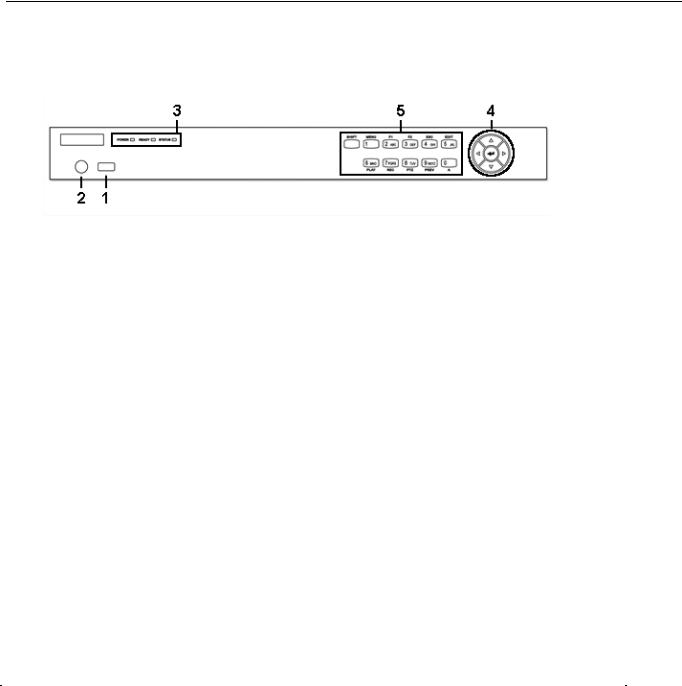
User Manual of Digital Video Recorder User Manual
1.1 Front Panels
|
|
|
|
|
|
|
Front Panel of EZHD-TVL4/8/16ch DVRs |
|
|
|
|
|
|
|
|
|
No. |
|
|
Name |
|
|
Function Description |
|
1 |
|
|
USB Interface |
|
|
Connect to USB mouse or USB flash memory. |
|
2 |
|
|
IR Receiver |
|
|
Receiver for IR remote control. |
|
|
|
|
POWER |
|
|
Power indicator lights in green when DVR is powered up. |
|
|
|
|
|
|
|
Indicator turns green when DVR is controlled by an IR remote control with the address from |
|
|
|
|
|
|
1~254; |
|
|
|
|
|
|
|
|
Indicator turns red when the SHIFT button is used; |
|
|
|
|
|
|
|
Indicator does not light when the DVR is controlled by a keyboard or by the IR remote control |
|
|
|
|
|
|
|
with the address of 255; |
|
3 |
|
|
STATUS |
|
|
Indicator turns green when the DVR is controlled by IR remote control (with the address from |
|
|
|
|
|
|
|
1~254) and keyboard at the same time , and the SHIFT button is not used; |
|
|
|
|
|
|
|
Indicator turns orange : (a) when the DVR is controlled by IR remote control (with the address |
|
|
|
|
|
|
|
from 1~254) and keyboard at the same time and the SHIFT button is used as well; (b) when the |
|
|
|
|
|
|
|
DVR is controlled by IR remote control (with the address from 1~254) and the SHIFT button is |
|
|
|
|
|
|
|
used. |
|
|
|
|
|
TX/RX indictor blinks in green when network connection is functioning properly. |
||
|
|
|
|
Tx/Rx |
|
|
|
|
|
|
|
|
|
|
The DIRECTION buttons are used to navigate between different fields and items in menus. |
|
|
|
|
|
|
|
In Playback mode, the Up and Down button is used to speed up and slow down recorded video. |
|
|
|
|
|
|
|
In All-day Playback mode, the Left/Right button can be used to select the recorded video for the |
|
|
|
|
DIRECTION |
|
|
next/previous day; in Playback by Normal Video Search, the Left/Right button can be used to |
|
|
|
|
|
|
|
select the next/previous recorded file. |
|
4 |
|
|
|
|
|
In Live View mode, the directional buttons can be used to cycle through channels. |
|
|
|
|
|
|
In PTZ control mode, it can control the movement of a PTZ camera. |
|
|
|
|
|
|
|
|
|
|
|
|
|
|
|
|
Confirm selection in any of the menu modes. It can also be used to tick checkbox fields. |
|
|
|
|
|
|
|
|
|
|
|
|
|
|
|
In Playback mode, it can be used to play or pause the video. |
|
|
|
|
ENTER |
|
|
In Single-frame Playback mode, pressing the ENTER button will advance the video by a single |
|
|
|
|
|
|
|
frame. |
|
|
|
|
|
|
|
In Auto-switch mode, it can be used to stop/start auto switch. |
|
|
|
|
SHIFT |
|
|
Switches compound keys between the numeric/letter input and functional control. |
|
|
|
|
|
|
|
|
|
|
|
|
1/MENU |
|
|
Enter numeral “1”; |
|
|
|
|
|
|
Access the main menu interface. |
|
|
|
|
|
|
|
|
|
|
|
|
|
|
|
|
Enter numeral “2”; |
|
|
|
|
|
|
|
|
|
|
|
|
|
|
|
Enter letters “ABC”; |
|
|
|
|
2ABC/F1 |
|
|
The F1 button can be used to select all items on the list; |
|
|
|
|
|
|
In PTZ Control mode, the F1 button can be used to zoom out (zoom-) the PTZ camera; |
|
|
|
|
|
|
|
|
|
|
5 |
|
|
|
|
|
In live view or playback mode, the F1 button can be used to switch between main and spot |
|
|
|
|
|
|
video output. |
|
|
|
|
|
|
|
|
|
|
|
|
|
|
|
|
Enter numeral “3”; |
|
|
|
|
3DEF/F2 |
|
|
Enter letters “DEF”; |
|
|
|
|
|
|
In PTZ Control mode, the F1 button can be used to zoom in (zoom+) the PTZ camera; |
|
|
|
|
|
|
|
|
|
|
|
|
|
|
|
|
The F2 button can be used to cycle through tab pages. |
|
|
|
|
|
|
|
Enter numeral “4”; |
|
|
|
|
4GHI/ESC |
|
|
Enter letters “GHI”; |
|
|
|
|
|
|
|
Exit and back to the previous menu. |
|
|
|
|
5JKL/EDIT |
|
|
Enter numeral “5”; |
13
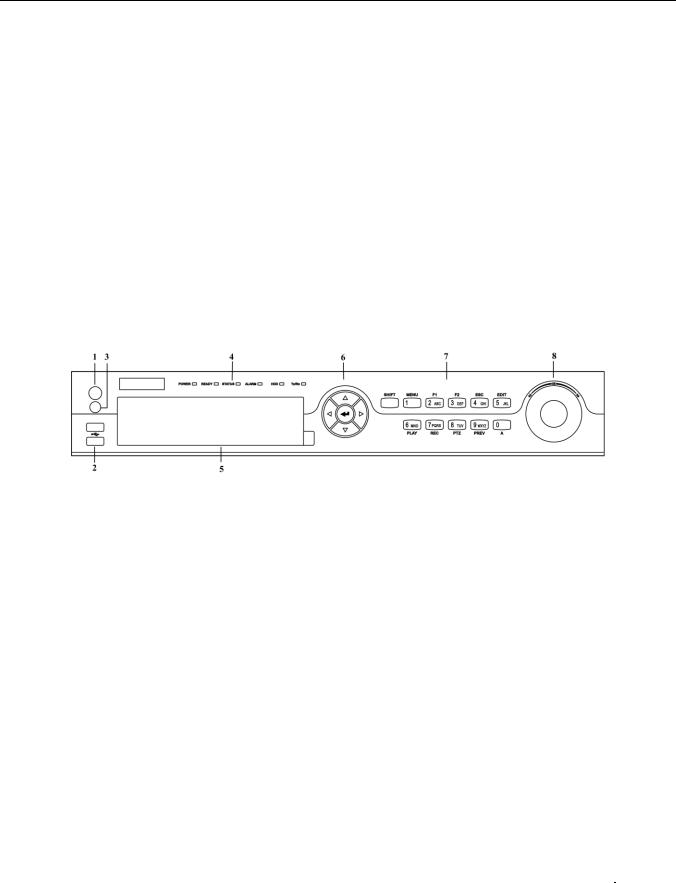
User Manual of Digital Video Recorder User Manual
|
|
Enter letters “JKL”; |
|
|
Delete characters before cursor; |
|
|
Select the checkbox and ON/OFF switch; |
|
|
Start/stop record clipping in playback. |
|
|
Enter numeral “6”; |
|
6MNO/PLAY |
Enter letters “MNO”; |
|
|
In Playback mode, it is used for direct access to playback interface. |
|
|
Enter numeral “7”; |
|
7PQRS/REC |
Enter letters “PQRS”; |
|
|
Manual record, for direct access to manual record interface; manually enable/disable record. |
|
|
Enter numeral “8”; |
|
8TUV/PTZ |
Enter letters “TUV”; |
|
|
Access PTZ control interface. |
|
|
Enter numeral “9”; |
|
|
Enter letters “WXYZ”; |
|
9WXYZ/PREV |
Multi-camera display in live view; |
|
|
In Playback mode or MenuPlaybackTag playback interface, this button can be used to |
|
|
delete the selected tag. |
|
|
Enter numeral “0”; |
|
|
Switch between input methods (upper and lowercase alphabet, symbols and numeric input). |
|
0/A |
In Playback mode, this button can be used to add the default tag. |
|
|
|
|
|
|
|
|
|
|
Front Panel of EZHD-TRF4/8/16 DVRs |
|
|
|
|
|
|
|
|
|
No. |
|
|
Name |
|
|
Function Description |
|
1 |
|
|
POWER ON/OFF |
|
|
Power on/off switch. |
|
2 |
|
|
USB Interface |
|
|
Connect to USB mouse or USB flash memory. |
|
|
|
|
Receiver for IR remote control. |
|||
|
3 |
|
|
IR Receiver |
|
|
|
|
|
|
|
POWER |
|
|
Power indicator lights in green when DVR is powered up. |
|
|
|
|
|
Ready indicator is normally green, indicating that the DVR is functioning properly. |
||
|
|
|
|
READY |
|
|
|
|
|
|
|
|
|
|
Indicator turns green when DVR is controlled by an IR remote control with the address from |
|
|
|
|
|
|
|
|
|
|
|
|
|
|
1~254; |
|
|
|
|
|
|
|
|
Indicator turns red when the SHIFT button is used; |
|
|
|
|
|
|
|
Indicator does not light when the DVR is controlled by a keyboard or by the IR remote control |
|
|
|
|
|
|
|
with the address of 255; |
|
4 |
|
|
STATUS |
|
|
Indicator turns green when the DVR is controlled by IR remote control (with the address from |
|
|
|
|
|
|
1~254) and keyboard at the same time , and the SHIFT button is not used; |
|
|
|
|
|
|
|
|
|
|
|
|
|
|
|
|
Indicator turns orange : (a) when the DVR is controlled by IR remote control (with the address |
|
|
|
|
|
|
|
from 1~254) and keyboard at the same time and the SHIFT button is used as well; (b) when |
|
|
|
|
|
|
|
the DVR is controlled by IR remote control (with the address from 1~254) and the SHIFT |
|
|
|
|
|
|
|
button is used. |
|
|
|
|
ALARM |
|
|
Alarm indicator turns red when a sensor alarm is detected. |
|
|
|
|
HDD |
|
|
HDD indicator blinks in red when data is being read from or written to HDD. |
|
|
|
|
Tx/Rx |
|
|
TX/RX indictor blinks in green when network connection is functioning properly. |
|
5 |
|
|
Not used |
|
|
N/A |
|
|
|
|
|
|
|
The DIRECTION buttons are used to navigate between different fields and items in menus. |
|
6 |
|
|
DIRECTION |
|
|
In Playback mode, the Up and Down button is used to speed up and slow down recorded |
|
|
|
|
|
video. |
||
|
|
|
|
|
|
|
|
|
|
|
|
|
|
|
In All-day Playback mode, the Left/Right button can be used to select the recorded video for |
14

User Manual of Digital Video Recorder User Manual
|
|
|
|
|
|
|
the next/previous day; in Playback by Normal Video Search, the Left/Right button can be used |
|
|
|
|
|
|
|
|
to select the next/previous recorded file. |
|
|
|
|
|
|
|
|
In Live View mode, the directional buttons can be used to cycle through channels. |
|
|
|
|
|
|
|
|
In PTZ control mode, it can control the movement of a PTZ camera. |
|
|
|
|
|
|
|
|
Confirm selection in any of the menu modes. It can also be used to tick checkbox fields. |
|
|
|
|
|
|
|
|
In Playback mode, it can be used to play or pause the video. |
|
|
|
|
|
|
ENTER |
|
In Single-frame Playback mode, pressing the ENTER button will advance the video by a |
|
|
|
|
|
|
|
|
single frame. |
|
|
|
|
|
|
|
|
In Auto-switch mode, it can be used to stop /start auto switch. |
|
|
|
|
|
|
SHIFT |
|
Switches compound keys between the numeric/letter input and functional control. |
|
|
|
|
|
|
|
|
|
|
|
|
|
|
|
1/MENU |
|
Enter numeral “1”; |
|
|
|
|
|
|
|
Access the main menu interface. |
|
|
|
|
|
|
|
|
|
|
|
|
|
|
|
|
|
|
Enter numeral “2”; |
|
|
|
|
|
|
|
|
Enter letters “ABC”; |
|
|
|
|
|
|
2ABC/F1 |
|
The F1 button can be used to select all items on the list; |
|
|
|
|
|
|
|
In PTZ Control mode, the F1 button can be used to zoom out (zoom-) the PTZ camera; |
|
|
|
|
|
|
|
|
|
|
|
|
|
|
|
|
|
|
In live view or playback mode, the F1 button can be used to switch between main and spot |
|
|
|
|
|
|
|
|
video output. |
|
|
|
|
|
|
|
|
Enter numeral “3”; |
|
|
|
|
|
|
3DEF/F2 |
|
Enter letters “DEF”; |
|
|
|
|
|
|
|
In PTZ Control mode, the F1 button can be used to zoom in (zoom+) the PTZ camera; |
|
|
|
|
|
|
|
|
|
|
|
|
|
|
|
|
|
|
The F2 button can be used to cycle through tab pages. |
|
|
|
|
|
|
|
|
Enter numeral “4”; |
|
|
|
|
|
|
|
|
|
|
|
|
|
|
|
4GHI/ESC |
|
Enter letters “GHI”; |
|
|
|
|
|
|
|
|
Exit and back to the previous menu. |
|
|
|
|
|
|
|
|
Enter numeral “5”; |
|
|
|
|
|
|
|
|
Enter letters “JKL”; |
|
|
|
7 |
|
|
5JKL/EDIT |
|
Delete characters before cursor; |
|
|
|
|
|
|
|
Select the checkbox and ON/OFF switch; |
|
|
|
|
|
|
|
|
|
|
|
|
|
|
|
|
|
|
Start/stop record clipping in playback. |
|
|
|
|
|
|
|
|
Enter numeral “6”; |
|
|
|
|
|
|
6MNO/PLAY |
|
Enter letters “MNO”; |
|
|
|
|
|
|
|
|
In Playback mode, it is used for direct access to playback interface. |
|
|
|
|
|
|
|
|
Enter numeral “7”; |
|
|
|
|
|
|
7PQRS/REC |
|
Enter letters “PQRS”; |
|
|
|
|
|
|
|
|
Manual record, for direct access to manual record interface; manually enable/disable record. |
|
|
|
|
|
|
|
|
Enter numeral “8”; |
|
|
|
|
|
|
8TUV/PTZ |
|
Enter letters “TUV”; |
|
|
|
|
|
|
|
|
Access PTZ control interface. |
|
|
|
|
|
|
|
|
Enter numeral “9”; |
|
|
|
|
|
|
|
|
Enter letters “WXYZ”; |
|
|
|
|
|
|
9WXYZ/PREV |
|
Multi-camera display in live view; |
|
|
|
|
|
|
|
|
In Playback mode or MenuPlaybackTag playback interface, this button can be used to |
|
|
|
|
|
|
|
|
delete the selected tag. |
|
|
|
|
|
|
|
|
Enter numeral “0”; |
|
|
|
|
|
|
|
|
|
|
|
|
|
|
|
|
|
Switch between input methods (upper and lowercase alphabet, symbols and numeric input). |
|
|
|
|
|
|
0/A |
|
In Playback mode, this button can be used to add the default tag. |
|
|
|
|
|
|
|
|
|
|
|
|
|
|
|
|
|
Move the active selection in a menu. The inner ring will move the selection up and down; the |
|
|
|
|
|
|
|
|
outer ring will move it left and right. |
|
|
|
8 |
|
|
JOG SHUTTLE |
|
In Playback mode, the inner ring is used to jump 30s forward/backward in video files. The |
|
|
|
|
|
Control |
|
outer ring can be used to speed up/slow down the video. |
|
|
|
|
|
|
|
|
|
||
|
|
|
|
|
|
|
In Live View mode, it can be used to cycle through different channels. |
|
|
|
|
|
|
|
|
In PTZ control mode, in can control the movement of the PTZ camera. |
|
15
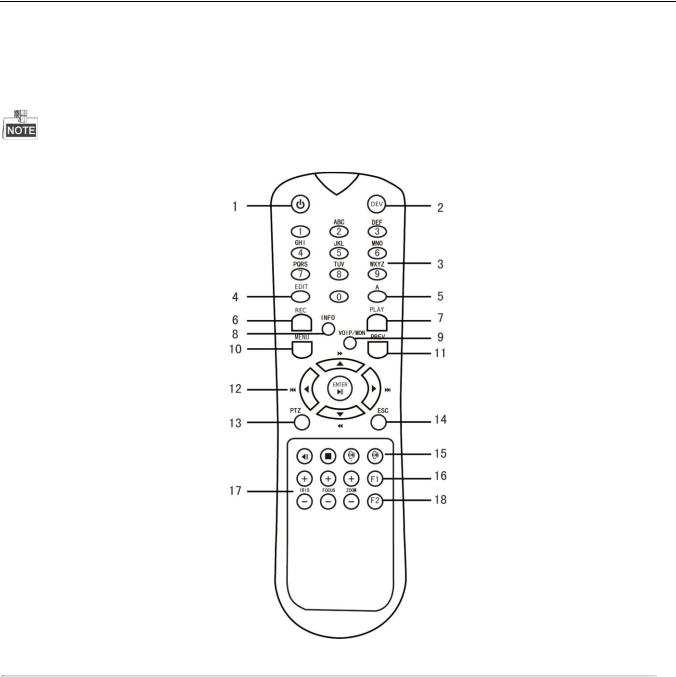
User Manual of Digital Video Recorder User Manual
1.2 IR Remote Control Operations
The DVR may also be controlled with the included IR remote control, shown in 1.1.
Batteries (2×AAA) must be installed before operation.
Figure 1. 1 Remote Control
The keys on the remote control closely resemble the ones found on the front panel. Refer to Table 1.1, they include:
Table 1. 1 Description of the IR Remote Control Buttons
No. |
Name |
Description |
|
1 |
POWER |
Power on/off the device. |
|
2 |
DEV |
Enables/Disables Remote Control. |
|
3 |
Alphanumeric Buttons |
Same as Alphanumeric buttons on front panel. |
|
4 |
EDIT Button |
Same as EDIT/IRIS+ button on front panel. |
|
5 |
A Button |
Same as A/FOCUS+ button on front panel. |
|
6 |
REC Button |
Same as REC/SHOT button on front panel. |
|
|
|
|
|
16

User Manual of Digital Video Recorder User Manual
No. |
Name |
Description |
|
7 |
PLAY Button |
Same as the PLAY/AUTO button on front panel. |
|
8 |
INFO Button |
Same as the ZOOM+ button on front panel. |
|
9 |
VOIP/MON Button |
Same as the MAIN/SPOT/ZOOMbutton on front panel. |
|
10 |
MENU Button |
Same as the MENU/WIPER button on front panel. |
|
11 |
PREV Button |
Same as the PREV/FOCUSbutton on front panel. |
|
12 |
DIRECTION/ENTER Buttons |
Same as the DIRECTION/ENTER buttons on front panel. |
|
13 |
PTZ Button |
Same as the PTZ/IRISbutton on front panel. |
|
14 |
ESC Button |
Same as the ESC button on front panel. |
|
15 |
RESERVED |
Reserved for future usage. |
|
16 |
F1 Button |
Same as the F1/LIGHT button on front panel. |
|
17 |
PTZ Control Buttons |
Buttons to adjust the iris, focus and zoom of a PTZ camera. |
|
18 |
F2 Button |
Same as the F2/AUX button on front panel. |
|
|
|
|
|
Troubleshooting the Remote Control:
Make sure you have installed batteries properly in the remote control. You must aim the remote control at the IR receiver in the front panel.
If there is no response after you press any button on the remote, follow the procedure below to troubleshoot.
Steps:
1.Go into Menu > Settings > General > More Settings by operating the front control panel or the mouse.
2.Check and remember DVR ID number. The default ID number is 255. This ID number is valid for all IR remote controls.
3.Press the DEV button on the remote control.
4.Enter the DVR ID number from step 2.
5.Press the ENTER button on the remote.
If the Status indicator on the front panel turns blue, the remote control is operating properly. If the Status indicator does not turn blue and there is still no response from the remote, please check the following:
1.Batteries are installed correctly and the polarities of the batteries are not reversed.
2.Batteries are fresh and not out of charge.
3.IR receiver is not obstructed.
If the remote still cannot function properly, please change the remote and try again, or contact your provider.
17

User Manual of Digital Video Recorder User Manual
1.3 USB Mouse Operation
A regular 3-button (Left/Right/Scroll-wheel) USB mouse is provided with this DVR. To use a USB mouse:
Steps:
1.Plug USB mouse into one of the USB interfaces on the front panel of the DVR.
2.The mouse should automatically be detected. If in a rare case that the mouse is not detected, the possible reason may be that the two devices are not compatible, please refer to the recommended the device list from your provider.
The operation of the mouse:
|
|
|
|
|
Table 1. 2 Description of the Mouse Control |
|
|
|
|
|
|
|
Name |
|
Action |
|
Description |
|
|
|
Single-Click |
|
Live view: Select channel and show the quick set menu. |
|
|
|
|
|
Menu: Select and enter. |
|
|
|
Double-Click |
|
Live view: Switch between single-screen and multi-screen. |
|
Left-Click |
|
Click and Drag |
|
PTZ control: Pan/tilt |
|
|
|
|
|
Privacy mask and motion detection: Select target area. |
|
|
|
|
|
Digital zoom-in: Drag and select target area. |
|
|
|
|
|
Live view: Drag channel/time bar. |
|
|
|
|
|
Live view: Show menu. |
|
Right-Click |
|
Single-Click |
|
|
|
|
|
|
|
Menu: Exit current menu to upper level menu. |
|
Scroll-Wheel |
|
Scrolling up |
|
Live view: Previous screen. |
|
|
|
|
|
Menu: Previous item. |
|
|
|
Scrolling down |
|
Live view: Next screen. |
|
|
|
|
|
Menu: Next item. |
|
|
|
|
|
|
18
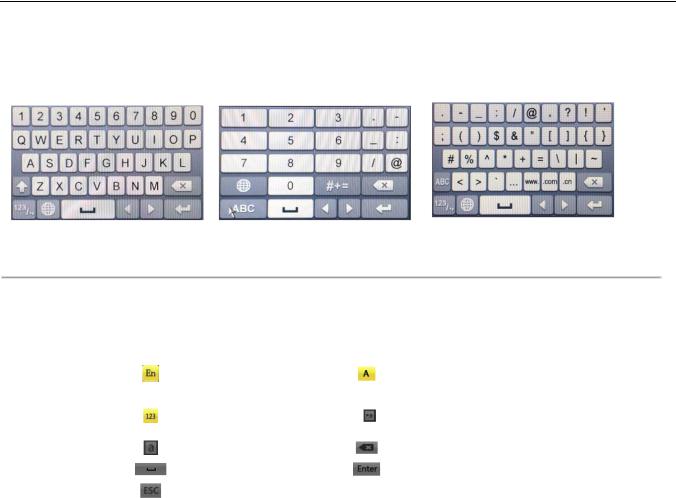
User Manual of Digital Video Recorder User Manual
Input Method Description
Initial Alphanumeric |
Numeric |
Symbols |
Figure 1.1 Soft Keyboards
Description of the buttons on the soft keyboard:
Table 1.1 Description of the Soft Keyboard Icons
|
Icons |
|
Description |
|
Icons |
|
Description |
|
|
|
|
||||
|
|
|
Indicates lower case |
|
|
|
Indicates Caps |
|
|
|
(click to change) |
|
|
|
(click to change) |
|
|
|
Indicates number pad |
|
|
|
Brings up |
|
|
|
|
|
|
||
|
|
|
(click to change) |
|
|
|
Symbol entry popup |
|
|
|
Toggle Lowercase/Uppercase |
|
|
|
Backspace |
|
|
|
|
|
|
||
|
|
|
Space |
|
|
|
Enter |
|
|
|
|
|
|
||
|
|
|
Exit |
|
|
|
|
|
|
|
|
|
|
|
|
19
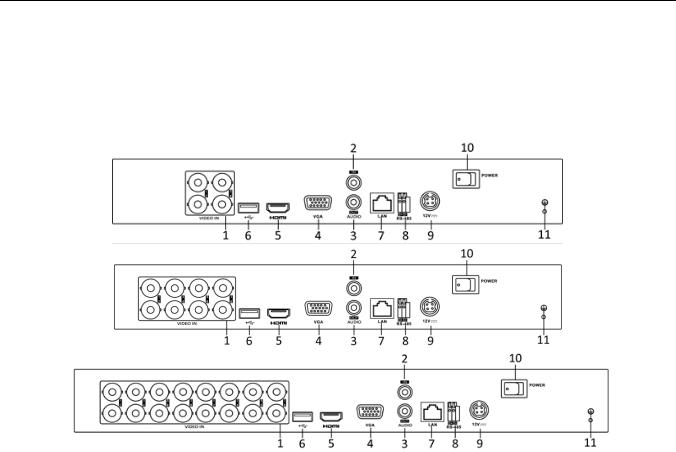
User Manual of Digital Video Recorder User Manual
1.4 EZHD-TVL Rear Panels
The rear panels vary slightly for different models in terms of size and nymber of BNC camera inputs.
|
|
Rear panel of 4ch/8ch/16ch EZHD-TVL DVRs |
|
|
|
|
Description of Rear Panel |
|
|
|
|
No. |
Item |
|
Description |
1 |
VIDEO IN |
|
BNC interface for TVI and/or analog video input; adjusts automatically |
2 |
AUDIO IN |
|
RCA connector – Line in |
3 |
AUDIO OUT |
|
RCA connector – Line out |
4 |
VGA |
|
DB15 connector for VGA output. Displays local video output and menu. |
5 |
HDMI |
|
HDMI video output connector. Displays local video output and menu. |
6 |
USB Port |
|
Universal Serial Bus (USB) port for additional devices. |
7 |
Network Interface |
|
Connector for network |
8 |
RS-485 Interface |
|
Output for RS-485 devices. |
9 |
Power Supply |
|
DC 12V power supply input |
10 |
Power Switch |
|
Switch for turning power on/off |
11 |
GND |
|
Ground |
1.5 RS-485 Connection EZHD-TVL
For 4ch/8ch/16ch DVR
20
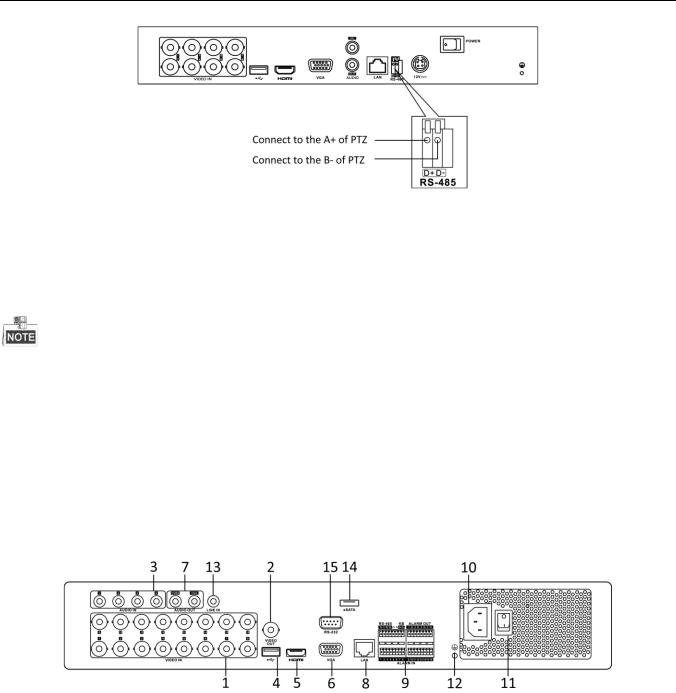
User Manual of Digital Video Recorder User Manual
To connect PTZ to the DVR:
1.Disconnect pluggable block from the RS-485 terminal block.
2.Press and hold the orange part of the pluggable block; insert signal cables into slots and release the orange part. Ensure signal cables are in tight.
3.Connect A+ on PTZ to D+ on terminal block and B- on controller to D- on terminal block. Fasten stop screws.
4.Connect pluggable block back into terminal block.
Make sure the DVR is grounded.
1.6 EZHD-TRF Rear Panels
For EZHD-TRF models, the rear panel vaires primarily in terms of the number of BNC camera inputs. Openings for 16 BNCs exist; unused
openings are closed with plastic covers.
|
|
Description of Rear Panel |
|
|
|
No. |
Item |
Description |
1 |
VIDEO IN |
BNC interface for TVI and/or CVBS analog video input. |
2 |
VIDEO OUT |
BNC connector for CVBS main monitor video output. |
3 |
AUDIO IN |
RCA connectors (line in) for recording audio |
4 |
USB Port |
Universal Serial Bus (USB) port for additional devices. |
5 |
HDMI |
HDMI main monitor video output connector. Display local video |
|
|
output and menu. HDMI and VGA display the same image(s). |
6 |
VGA |
DB15 connector for main monitor VGA output. Display local video |
21

User Manual of Digital Video Recorder User Manual
No. |
Item |
Description |
|
|
output and menu. HDMI and VGA display the same image(s). |
7 |
AUDIO OUT |
RCA connectors for audio playback through VGA or CVBS monitor |
8 |
Network Interface |
Connector for LAN/WAN network interface |
9 |
RS-485 Interface |
Connector for RS-485 devices. T+ and T- pins connect to R+ and R- |
|
|
pins of PTZ receiver respectively. |
|
|
D+, D- pin connects to Ta, Tb pin of controller. For cascading |
|
|
devices, the first DVR’s D+, D- pin should be connected with the |
|
|
D+, D- pin of the next DVR. |
|
|
Connectors (16) for alarm inputs. |
|
|
Connectors (4) for alarm outputs. |
10 |
Power Supply |
AC 100 ~ 240V power supply. |
11 |
Power Switch |
Switch for turning power on/off (“hard” power off). |
12 |
GND |
Ground |
13 |
LINE IN |
BNC connector for two-way audio input. |
14 |
eSATA |
Connects external SATA HDD, CD/DVD-RW. |
15 |
RS-232 Interface |
Connector for RS-232 (future use) |
1.7 EZHD-TRF Peripheral Connections
Wiring of Alarm Inputs
The alarm inputs require an open/closed relay or other ‘dry’ contact. To connect the alarm input to the device, use the following diagram.
If the alarm input is not an open/close relay or ‘dry’ contact, please connect an external relay between the alarm input and the device.
Wiring of Alarm Outputs
To connect to an alarm output (AC or DC load), use the following diagram: 22
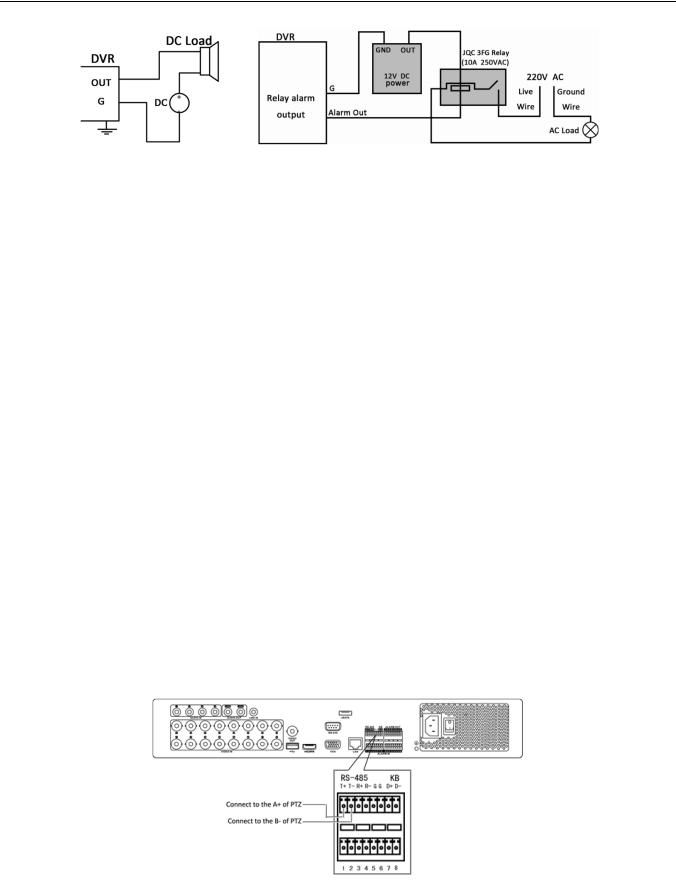
User Manual of Digital Video Recorder User Manual
DC Load Connection Diagram AC Load Connection Diagram
For DC loads, the outputs can be used with the jumpers in place, within the limit of 12V/1A safely.
To connect an AC load, jumpers should be removed (you must remove the jumper on the motherboard in the DVR). Do NOT connect high voltage to/through the DVR relays. Use an external relay for safety (as shown in the figure above).
There are 4 jumpers (JP1, JP2, JP3, and JP4) on the motherboard, each corresponding with one alarm output. By default, jumpers are connected. To connect an AC load, jumpers should be removed.
Example:
If you connect an AC load to the alarm output 3 of the DVR, then you must remove the jumper JP 3.
1.8 Alarm Connection
To connect alarm devices to the DVR:
1.Disconnect pluggable block from the ALARM IN /ALARM OUT terminal block.
2.Press and hold the orange part of the pluggable block; insert signal cables into slots and release the orange part. Ensure signal cables are in tight.
3.Connect pluggable block back into terminal block.
1.9 RS-485 Connection
5.Disconnect pluggable block from the RS-485 terminal block.
6.Press and hold the orange part of the pluggable block; insert signal cables into slots and release the orange part. Ensure signal cables are in tight.
7.Connect A+ on PTZ to D+ on terminal block and B- on controller to D- on terminal block. Fasten stop screws.
8.Connect pluggable block back into terminal block.
23

User Manual of Digital Video Recorder User Manual
To connect PTZ to the DVR:
1.Disconnect pluggable block from the RS-485 terminal block.
2.Press and hold the orange part of the pluggable block; insert signal cables into slots and release the orange part. Ensure signal cables are in tight.
3.Connect A+ on PTZ to T+ on terminal block and B- on controller to T- on terminal block. Fasten stop screws.
4.Connect pluggable block back into terminal block.
Make sure the DVR is grounded.
24

User Manual of Digital Video Recorder User Manual
Chapter 2 Getting Started
25
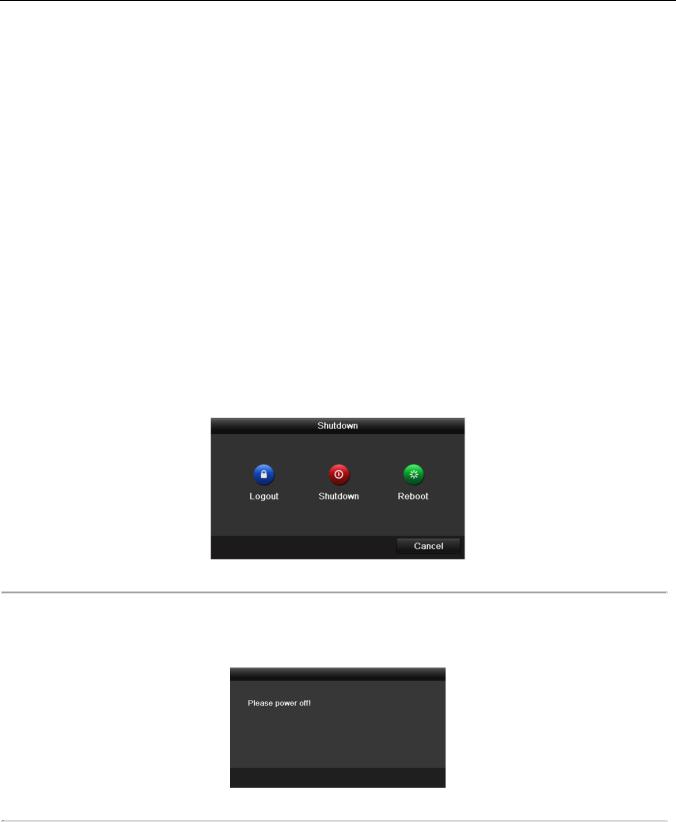
User Manual of Digital Video Recorder User Manual
2.1 Starting Up and Shutting Down the DVR
Purpose:
Proper startup and shutdown procedures are crucial to extending the life of the DVR.
Before you start:
Check that the voltage of and external power supply matches the DVR’s requirement, and the ground connection is functioning properly.
Starting up the DVR
Steps:
1.Check the power supply is plugged into the proper electrical outlet. It is HIGHLY recommended that an Uninterruptible Power Supply (UPS) be used in conjunction with the device.
2.Turn on the power switch on the rear panel, and the Power indicator LED should turn on indicating that the unit has begun to start up.
3.After startup, the Power indicator LED remains on.
Shutting down the DVR
Steps:
There are two proper ways to shut down the DVR. To shut down the DVR:
OPTION 1: Standard shutdown
1.Enter the Shutdown menu. Menu > Shutdown
Figure 2. 1 Shutdown Menu
2.Select the Shutdown button.
3.Click the Yes button.
4.Turn off the power switch on the rear panel when the note appears.
Figure 2. 2 Shutdown Tips
OPTION 2: By operating the front panel button (for EZHD-TRF series) 1. Press and hold the POWER button on the front panel for 3 seconds.
26

User Manual of Digital Video Recorder User Manual
2.Enter the administrator’s username and password in the dialog box for authentication.
3.Click the Yes button.
Do not press the POWER button again when the system is shutting down.
The device remains standby mode after shutting down, and the POWER indicator turns red; you can turn on the device by pressing the POWER button on the remote control.
Rebooting the DVR
While in the Shutdown menu (Figure 2. 1), you can also reboot the DVR.
Steps:
1.Enter the Shutdown menu by clicking Menu > Shutdown.
2.Click the Logout button to log out or the Reboot button to reboot the DVR.
27
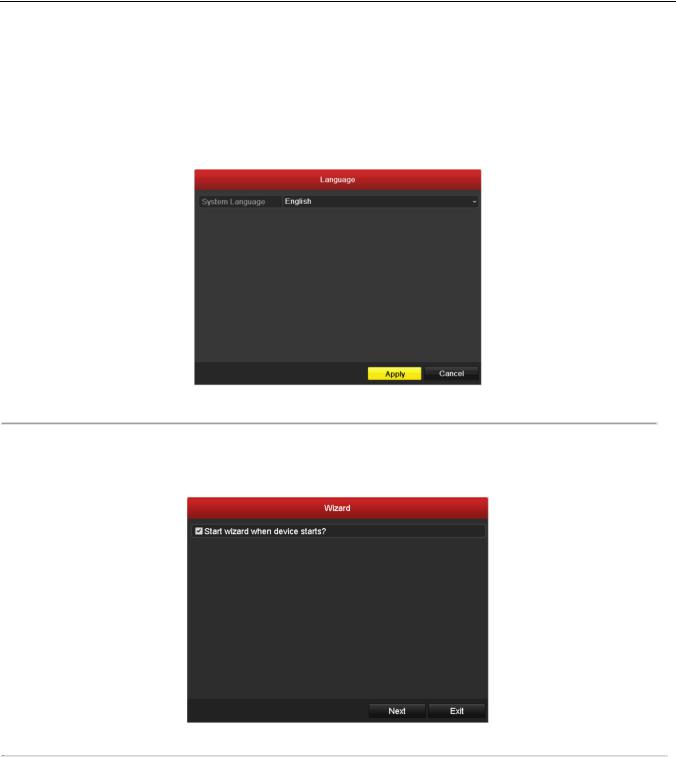
User Manual of Digital Video Recorder User Manual
2.2 Using the Wizard for Basic Configuration
By default, the Setup Wizard will start once the DVR has loaded, as shown in Figure 2. 3.
Steps:
1. Please select the system language in the drop-down list as desired
Figure 2. 3 Language Selection
2.The Setup Wizard can walk you through some important settings on the DVR. If you do not want to use the Setup Wizard at this time, click the Cancel button. You can also choose to use the Setup Wizard next time by leaving the “Start wizard when device starts?” checkbox marked.
Figure 2. 4 Start Wizard Interface
3. Click Next button on the Wizard window to display the Login window, as shown in Figure 2. 5.
28
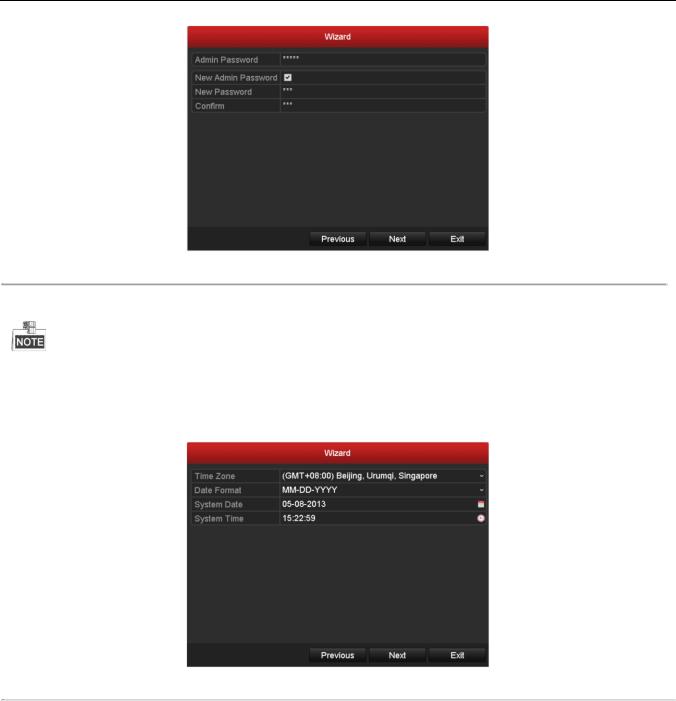
User Manual of Digital Video Recorder User Manual
Figure 2. 5 Login Window
4. Enter the admin password. By default, the password is 12345.
It is highly recommended to change the default password right after the first login to avoid security issues.
5.To change the admin password, check the New Admin Password checkbox. Enter the new password and confirm the password in the given fields.
6.Click the Next button to enter the date and time settings window, as shown in Figure 2. 6.
Figure 2. 6 Date and Time Settings
7.After the time settings, click Next button which will take you back to the General Network Setup Wizard window, as shown in Figure 2. 7.
29
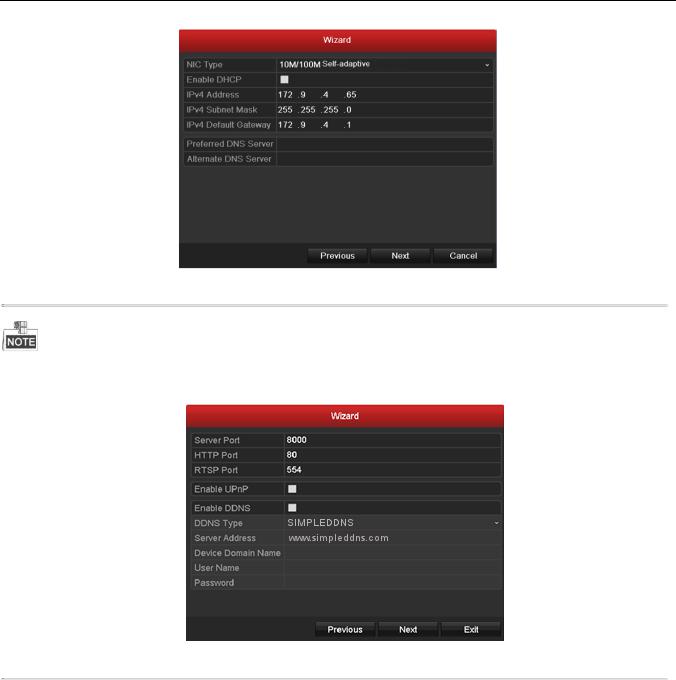
User Manual of Digital Video Recorder User Manual
Figure 2. 7 General Network Configuration
8.Click Next button after you having configured the network parameters, which will take you to the Advanced Network Setup Wizard window, as shown in Figure 2. 8.
Figure 2. 8 Advanced Network Configuration
9.Set the parameters of port No., Auto UPnP or DDNS if required.
10.Click Next button after configuring the advanced network parameters, which will take you to the HDD Management window, shown in Figure 2. 9.
30
